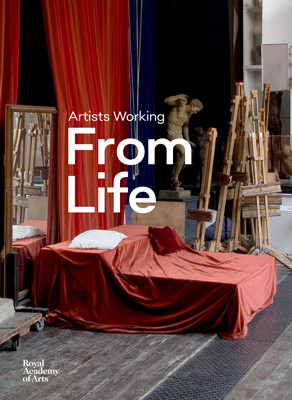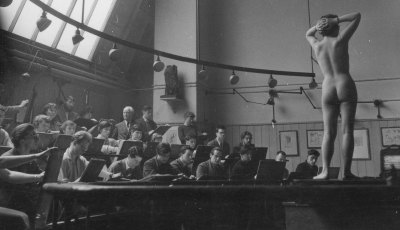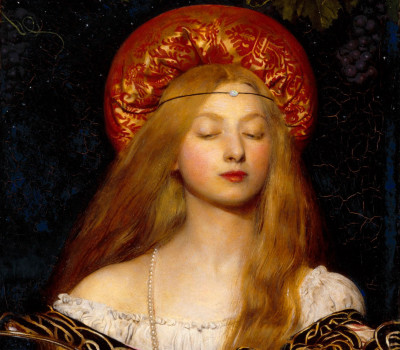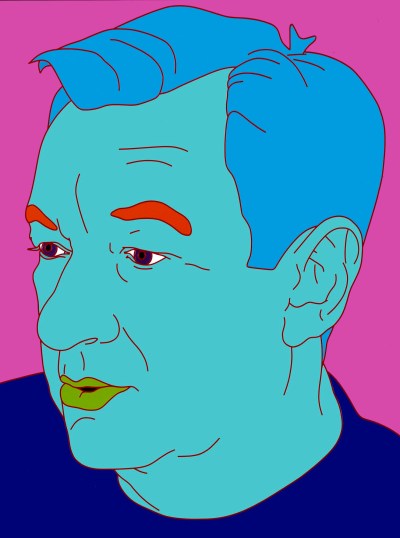Chantal Joffe RA: “If I can paint it, I can deal with it”
Chantal Joffe RA: “If I can paint it, I can deal with it”
By Adrian Locke
Published 23 February 2018
With a nude self-portrait currently on show in our From Life exhibition, Chantal Joffe discusses her models, inspiration and artistic process with the show’s curator, Adrian Locke.
-
-
Chantal Joffe RA’s work is about people, particularly those close to her: portraits of her partner Dan Coombs, her daughter Esme, her close friend Ishbel Myerscough, as well as a significant number of self-portraits, painted from a mirror or from photographs taken of her by Coombs. The self-portraits are therapeutic. “When things are hard in my life I will paint myself,” Joffe explains. “It is a way of saying I am okay. If I can paint that then I can deal with it. It’s a way of owning it, of holding onto a moment. Painting is the absolute present tense of a moment.”
Working from life in this way, in Joffe’s words, “records one’s own journey through life – this is what I saw, my view, my history”. She recalls how she once gave a talk at a college in which she arranged a chronological sequence of self-portraits: “I did that for myself. I loved it. You could see all my obsessions. They stirred my emotions when I looked at them. Self-portraits are as close as I can get to writing a memoir.” Besides, she adds, “you can do anything you want to yourself. Enlarge yourself, shrink yourself.”
Combined with her love for reading, particularly memoirs, as well as photography, the practice of working from life has made Joffe into an avid observer, forever looking at the world around her. This attention can be intense. She confesses: “I swim to clear my head, although the swimming pool is a hard place for me – it’s like a feast.” Likewise New York, a city she describes as “full of magic, the casualness of weirdness”. The challenge for someone who observes life as much as Joffe is to separate what she has seen from what she is looking at when she is painting – to clear her mind and focus on the subject in front of her.
Her appetite for observation is evident in her painting and pastels, where the energy and speed of her brushwork and drawing, the need to capture the intensity of the moment, are palpable. “I like speed – through speed things happen that you don’t anticipate,” she says, although, she adds, “I have to slow myself down, so that I’m not done before I’m started.” Joffe gauges the pace at which she works, in order not to lose the vital essence of the subject by working too quickly.
“Nobody talks about the energy you need to paint, to be so in the moment and to paint fast, physically,” she continues. “It is such an introspective activity. You are on your own most of the time. To find a place to actually paint, and the energy, to harness it all, to hold on to the discipline and balance, is hard. You need to paint with a level of anxiety, of truth.”
Joffe is conscious of the distinct challenges that confront women artists and admires pioneering female painters who worked from life, such as the French Impressionist Berthe Morisot, the German Expressionist Paula Modersohn-Becker and Alice Neel, the American portrait painter, acknowledging how courageous they were. “Being a female artist is exciting. You don’t have the luxury of just saying I am an artist in the same way as men, historically. Maybe it is harder, but more interesting because of how hard it is. I have to believe in all the good that comes with it.”

-
-

Chantal Joffe RA, Self Portrait with Ishbel, 2014.

Chantal Joffe, Self Portrait at Night, 2015.

Chantal Joffe, Self-Portrait in the Garden at Night V, 2016.

Chantal Joffe, Self-Portrait Naked in Garden, 2016.
-
-
Pastel is “a perfect medium” for the artist. “You can go really hard with it,” she explains. “Very immediate. Very fast.” Self-portrait Naked in the Garden (2016) and her series ‘Self-portrait in the Garden at Night’ (2016) are pastels inspired by Turkish novelist Sabahattin Ali’s Madonna in a Fur Coat (1943), the story of a doomed relationship between a Turkish man and an artist in 1920s Berlin. “These pastels capture figures at night. Flesh at night. How you lose a lot of colour. The pallor of the flesh. Me seated on a garden chair. There is something about flesh near metal. Pure geometry against my own fleshiness.” She worked from photographs rather than a mirror. The contrast between the darkness of the background and the luminosity of her figure, intensified by the flash of the camera operated by Coombs, gives the works a slightly illicit feel. For Joffe, photography was the only way to capture the potency of the moment; working from photographs in this way, for Joffe, is working from life.
For some of her oil paintings, such as Self-portrait with Hand on Hip (2016), Joffe prepares panels in advance with homemade gesso, which is a laborious process. “It is difficult and time-consuming to do, but it makes the most incredible surface, like human skin. Really intoxicating. Two weeks just to prime the panels. It is actually painted fast, but the gesso absorbs the mark and slows you down.” The painting reflects Joffe’s fascination with the American artist Willem de Kooning, in particular his ‘Door Cycle’ series of female figures (1964–66), which he painted on the surface of hollow-core doors that had been previously installed in his studio; Joffe’s painting is exactly the same size as those in his series. She started by making a sequence of “blind” drawings, also inspired by De Kooning, who, in 1966, made 24 charcoal drawings of figures with his eyes closed. Doing this was part of her process of leading up to the painting – in her words “thinking your way into De Kooning”.
Working with her eyes closed also allowed her to realise “how little one thinks” when one draws or paints. Such intuition is evident in Joffe’s art, although that which appears so immediate and instinctive masks the deep thought, research and consideration that prefaces each body of her work.

-
-
From Life is at the RA until 11 March 2018.
-
-

Enjoyed this article?
Claim 20% off our book, 'Artists Working From Life'
This article is an extract from the first publication to question the meaning of working from life today. Artists Working From Life brings together interviews with 19 contemporary architects, painters, sculptors and conceptual artists to offer unexpected and inspiring viewpoints on a deeply rooted artistic tradition.
Enter FROMLIFE20 at checkout to claim your 20% discount.
-










